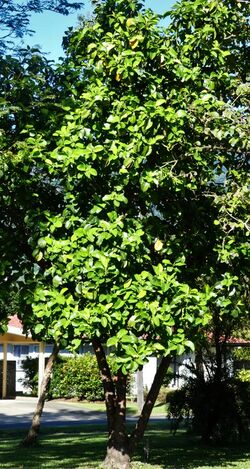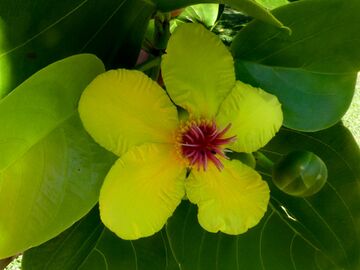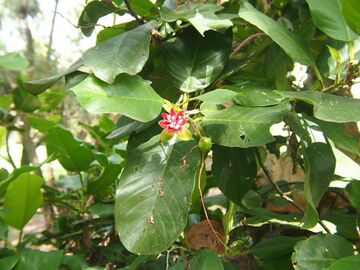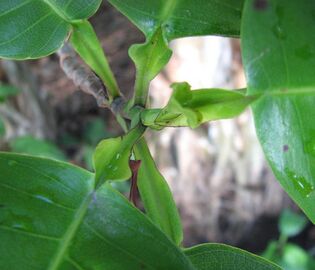Biology:Dillenia alata
| Red beech | |
|---|---|

| |
| Scientific classification | |
| Kingdom: | Plantae |
| Clade: | Tracheophytes |
| Clade: | Angiosperms |
| Clade: | Eudicots |
| Order: | Dilleniales |
| Family: | Dilleniaceae |
| Genus: | Dillenia |
| Species: | D. alata
|
| Binomial name | |
| Dillenia alata | |
| Synonyms[3] | |
| |
Dillenia alata, commonly known as red beech, golden guinea flower or golden guinea tree, is a tree in the Dilleniaceae family, found in tropical forests of the Moluccas, New Guinea, and northern Australia .[3][4]
Description
Dillenia alata is a medium-sized tree, growing to 10–15 m (33–49 ft) with a dense shady crown and distinctive reddish brown, papery, flaky bark.[5][6] The leaves are glossy dark green and rather large, measuring up to 25 cm (9.8 in) long and 12 cm (4.7 in) wide, with a broadly-winged petiole (leaf stalk) that sheaths the twig.[4][5][6]
The inflorescence is a raceme of 2-4 flowers borne on the twigs,[7] either terminally or more or less opposed to the leaves. The flowers are about 8 cm (3.1 in) across with five yellow petals and a prominent cluster of numerous pinkish-red stamens at the centre.[4][5][6]
Fruits are a red dehiscent capsule with a persistent green calyx and up to 8 valves (segments of the ovary) which open widely on maturity,[5][6] revealing a number of 4 mm (0.16 in) black seeds enclosed in a waxy white aril.[5][6][7]
Taxonomy
The species was originally named Wormia alata by the Scottish botanist Robert Brown, and later formally described in 1817 by the Swiss botanist Augustin Pyramus de Candolle.[8][9] His description was based on plant material collected by Joseph Banks at Point Lookout, Endeavour River, during James Cook's first voyage of discovery in 1770.[4]
The species was transferred to the genus Dillenia by Italian botanist Ugolino Martelli in 1886.[10][11]
Etymology
The genus name Dillenia was given in honour of the Germany -born botanist Johann Jacob Dillenius.[5][12] The species epithet, alata, is derived from the Latin āla and means "winged", referring to the winged petioles.[5][13]
Distribution and habitat
The species is native to the Maluku Islands, New Guinea, and the Torres Strait islands, the Northern Territory, and Queensland in Australia .[3][4][5][7] It usually grows in rainforest but may be found in monsoon forest and even open forest (in wet situations).[4][5]
It has been observed at up to 600 m (2,000 ft) in altitude but is more common in lowland forests, particularly on coastal lowlands.[4][7]
Ecology
This species is host to the Queensland moth Pollanisus commoni,[14] and the fruits are eaten by the Eclectus parrot.[5]
Conservation
D. alata is assessed as least concern by the IUCN, the Northern Territory Government and the Queensland Government.[1][7][15]
Cultivation
This species has "considerable horticultural merit",[4] and the Australian botanist David L. Jones, in his book Rainforest Plants of Australia, said "A striking ornamental, common along stream banks and in swampy soils. The leaves, bark, flowers and fruit are all highly decorative features".[6]
Gallery
References
- ↑ 1.0 1.1 Botanic Gardens Conservation International (BGCI) & IUCN SSC Global Tree Specialist Group (2019). "Dillenia alata". IUCN Red List of Threatened Species 2019: e.T136088987A144797929. doi:10.2305/IUCN.UK.2019-1.RLTS.T136088987A144797929.en. https://www.iucnredlist.org/species/136088987/144797929. Retrieved 7 May 2021.
- ↑ "Dillenia alata". Centre for Plant Biodiversity Research, Australian Government. http://id.biodiversity.org.au/name/apni/105242.
- ↑ 3.0 3.1 3.2 3.3 "Dillenia alata". Royal Botanic Gardens, Kew. http://powo.science.kew.org/taxon/146788-3.
- ↑ 4.0 4.1 4.2 4.3 4.4 4.5 4.6 4.7 "Dillenia alata". Centre for Australian National Biodiversity Research (CANBR), Australian Government. https://apps.lucidcentral.org/rainforest/text/entities/Dillenia_alata.htm.
- ↑ 5.0 5.1 5.2 5.3 5.4 5.5 5.6 5.7 5.8 5.9 Cooper, Wendy; Cooper, William T. (June 2004). Fruits of the Australian Tropical Rainforest. Clifton Hill, Victoria, Australia: Nokomis Editions. p. 150. ISBN 9780958174213. https://www.nokomis.com.au/product/nokomis-published-books/fruits-australian-tropical-rainforest/. Retrieved 8 May 2021.
- ↑ 6.0 6.1 6.2 6.3 6.4 6.5 Jones, David L. (1986). Rainforest Plants of Australia. Bowgowlah, NSW, Australia: Reed Books. p. 211. ISBN 0-7301-0381-1.
- ↑ 7.0 7.1 7.2 7.3 7.4 "Dillenia alata (R.Br. ex DC.) Martelli". Northern Territory Government. http://eflora.nt.gov.au/factsheet?id=1827.
- ↑ "Dillenia alata". Royal Botanic Gardens, Kew. https://www.ipni.org/n/146788-3.
- ↑ de Candolle, Augustin Pyramus (1817). Regni Vegetabilis Systema Naturale, sive Ordines, Genera et Species Plantarum Secundum Methodi Naturalis Normas Digestarum et Descriptarum. 1. pp. 434. https://www.biodiversitylibrary.org/page/41046609. Retrieved 7 May 2021.
- ↑ Martelli, U. (1886). Beccari, O.. ed. Malesia. 3. p. 157. doi:10.5962/bhl.title.79357. https://www.biodiversitylibrary.org/page/46108808. Retrieved 7 May 2021.
- ↑ "Martelli, U. in Beccari, O. (ed.) (1886), Malesia 3". Centre for Australian National Biodiversity Research, Australian Government. https://id.biodiversity.org.au/instance/apni/534683.
- ↑ Messina, André (2020). "Dilleniaceae". Australian Biological Resources Study, Department of Agriculture, Water and the Environment: Canberra. https://profiles.ala.org.au/opus/foa/profile/Dilleniaceae.
- ↑ Mabberley, D. (2017) Gooding, M., Mabberley, D., Studholme, J. (eds) Joseph Banks' Florilegium Botanical Treasures from Cook's First Voyage p222, Thames & Hudson, London.
- ↑ Beasley, John (2009). Plants of Cape York - the compact guide. John Beasley. p. 90. ISBN 978-0-9806863-0-2.
- ↑ "Species profile—Dillenia alata". Queensland Government. https://apps.des.qld.gov.au/species-search/details/?id=17433.
External links
- View a map of historical sightings of this species at the Australasian Virtual Herbarium
- View observations of this species on iNaturalist
- View images of this species on Flickriver
Wikidata ☰ Q16556709 entry
 |








